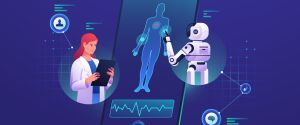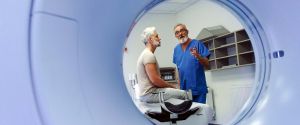AI That Puts People at the Top
In today’s AI-saturated headlines, the question is often framed as a binary: Will AI replace doctors? But this narrative misses a far more powerful truth—one that is unfolding every day inside hospitals and health systems. When built thoughtfully and applied responsibly, AI doesn’t replace clinicians. It promotes them. It fills in gaps, connects the dots, and delivers timely insights—so that human expertise can shine exactly where it’s needed most.
Healthcare, especially in the context of radiology follow-up, offers a compelling case study in how AI can elevate—not eliminate—the role of the clinician. From identifying overlooked recommendations to orchestrating care across fragmented systems, AI is proving to be a vital safety net. Through advanced with platforms, we’re seeing how human-centered AI can transform complex processes into streamlined, high-reliability operations that protect both patients and providers.
The Follow-Up Problem: A Human Issue at a Technological Breaking Point
Each year, roughly 370 million radiology studies are performed in the U.S. Nearly 10% of these—about 37 million—contain recommendations for follow-up. Yet, studies consistently show that as many as half of those recommendations are never completed. That translates into millions of missed opportunities to catch early signs of cancer, prevent disease progression, or deliver timely interventions.
The reasons for this failure are as human as they are systemic: unclear documentation, poor communication, fragmented responsibilities, and administrative overload. In other words, the issue isn’t just that follow-up falls through the cracks. It’s that the system isn’t built to catch it.
AI as Infrastructure, Not Interference
Artificial intelligence in healthcare is often portrayed as a disruptive force. But in reality, the most effective AI applications serve not as replacements for human expertise, but as infrastructure that reinforces and elevates it.
Nowhere is this more evident than in the realm of radiology follow-up. AI models—especially those trained on clinical language—can process unstructured imaging reports at scale, extracting both explicit and implicit follow-up recommendations. More than simple identification, advanced models can understand context: the imaging modality required, the urgency of the recommendation, and the appropriate timeframe for action.
This intelligence becomes exponentially more valuable when paired with automated workflows. From initiating patient outreach to tracking completion and escalation, AI enables healthcare systems to transform recommendations into structured, actionable tasks, before they slip through the cracks.
Reminders can be personalized, persistent, and tied to clinical risk. Patients are contacted through their preferred communication channels—text, email, portal, or mail—while clinicians are supported through EHR-integrated prompts and simplified ordering pathways. Real-time dashboards give leaders visibility into performance trends, overdue items, and population-level disparities—so that issues are addressed early and decisively.
Filling Gaps Without Creating New Silos
Many healthcare technologies solve one problem only to create another, forcing new logins, interrupting workflows, or flooding clinicians with unfiltered alerts. The most sustainable AI solutions avoid these traps by integrating directly into existing systems and standards, such as Epic, Cerner, HL7, and FHIR.
This seamless integration ensures that AI complements clinical workflows rather than complicating them. It also enables organizations to embed high-reliability principles—like redundancy, escalation protocols, and role clarity—into everyday operations.
Inspired by industries like aviation and nuclear energy, which tolerate no room for error, high-reliability healthcare requires systems that not only manage tasks, but anticipate where and how they might fail. Effective AI in this context acts as an early warning system by surfacing risks, flagging breakdowns, and ensuring that critical steps aren’t missed.
AI as the First Line of Engagement
In a strained healthcare environment marked by staffing shortages and rising imaging volumes, AI is not just helpful—it’s essential. Manually tracking follow-up recommendations is no longer feasible at scale. That’s where AI becomes a force multiplier.
Modern systems can automate the vast majority of follow-up orchestration, from detection and documentation to patient communication and compliance monitoring. This automation doesn’t replace human teams, it frees them to focus where human judgment matters most.
Health systems leveraging this type of AI are reporting significant improvements in follow-up closure, documentation quality, and operational efficiency. When AI identifies the right action at the right time, care teams can intervene earlier, prevent delays, and ultimately save lives.
From Data Chaos to Contextual Clarity
One of AI’s greatest advantages is its ability to see the full picture. Clinical data is often fragmented, unstructured, and longitudinal, making it difficult to track patient needs over time. But when AI is trained on real-world imaging narratives and clinical patterns, it can distinguish between historical and new findings, extract nuance from radiology language, and flag high-risk features that would otherwise be buried in text.
This is about contextual awareness. It’s about knowing not just that a follow-up is recommended, but why, how soon, and what risks are associated. With this depth of understanding, AI becomes a critical decision support tool by empowering clinical teams to act with confidence and clarity.
Protecting, Not Replacing, the Human Element
As AI adoption accelerates, the narrative must shift from replacement to reinforcement. The goal is not to automate away clinical roles, but to amplify the value of human care.
Burnout, administrative burden, and workflow inefficiencies are driving clinicians away from the bedside. AI, when designed with purpose, can reverse that trend by alleviating the manual tasks that drain time and energy.
As one healthcare leader put it:
“The most effective AI-enabled solutions elevate the work of the human. Technology should automate the administrative drag that distracts medical experts from patient care.”
Human-Centered AI Is the Future of High-Reliability Care
The future of healthcare isn’t defined by flashy tools. It’s defined by infrastructure that quietly, reliably ensures no patient is lost, no task goes untracked, and no clinician is overwhelmed.
Early adopters of intelligent follow-up systems are already seeing measurable outcomes:
- 50–75% increases in follow-up completion
- 20% gains in documentation appropriateness
- 90–95% reductions in manual task burden
- Significant increases in revenue recapture
- Stronger compliance and reduced liability exposure
These are not just numbers. They are proof that when AI is designed to support clinical care, it creates value that spans patient safety, provider well-being, and operational performance.
Keeping the Human at the Center
There is a persistent fear that AI will replace human roles in healthcare. But the more important and more realistic question is: what if AI could help us be more human?
What if it could eliminate the noise, surface what matters, and ensure that every patient gets the follow-up they deserve?
This is the promise of human-centered AI: not artificial intelligence for its own sake, but real intelligence in service of real people.
The era of AI has arrived. Let’s use it not to displace care—but to restore it, reinforce it, and raise the standard for what’s possible when the human is at the top.












